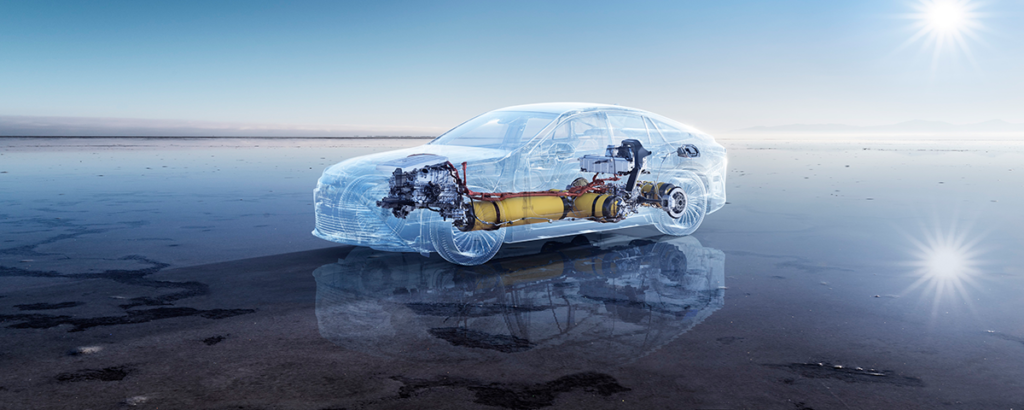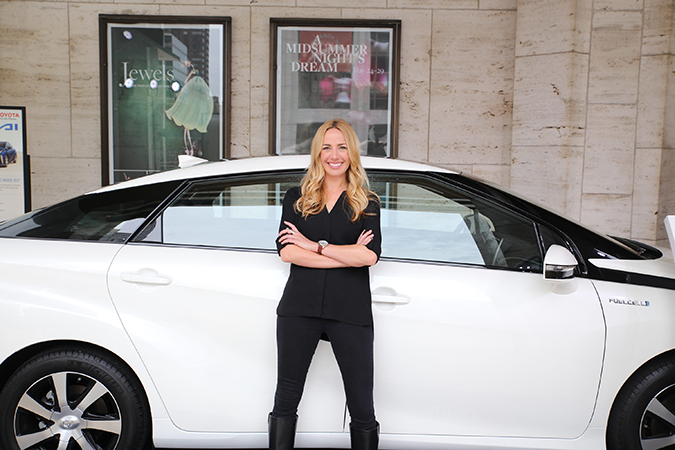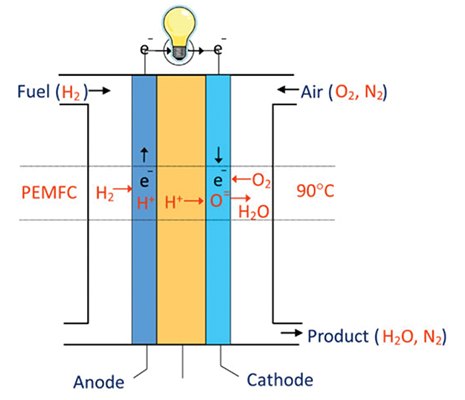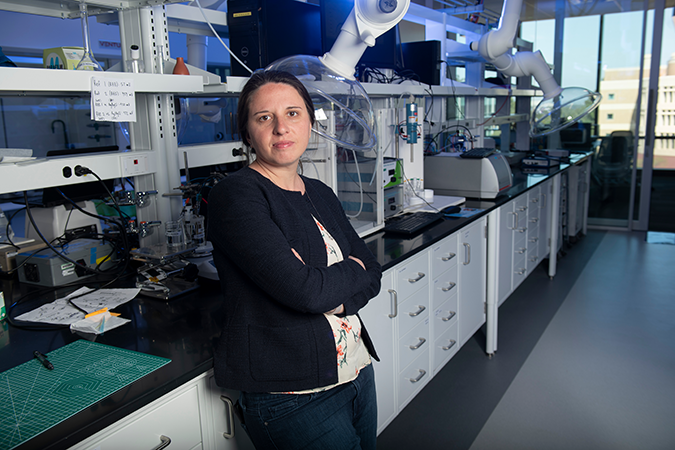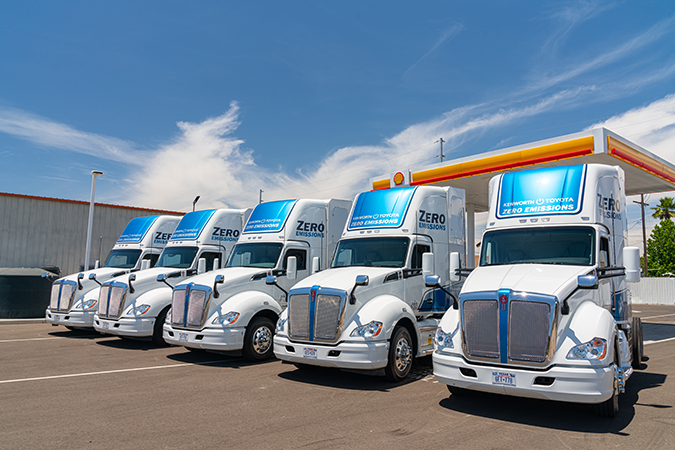In pre-pandemic 2019, the transportation sector poured 8.5 gigatons of carbon dioxide into the atmosphere, according to the International Energy Agency (IEA) - a big slice of the greenhouse gas emissions that fuel climate change. As the world's population grows, continued reliance on internal combustion engines will only bring more emissions, pollution, and congestion, and greater consequences for people and the environment. The transportation sector is one of the essential and biggest markets for zero-emission fuel cell and hydrogen deployment.
For Jackie Birdsall, senior engineering manager of the Fuel Cell Integration Group at Toyota North America R&D, this is a great time to be an automotive engineer. A self-described "gear head," she's been obsessed with cars since she learned to drive. "One of my first undergrad classes at Kettering University's General Motors Institute was in hybrid technology, and we were talking about oil dependency," she said. "I knew it was unsustainable, unacceptable. That one class completely changed my trajectory."
Birdsall first encountered hydrogen fuel cell electric vehicles (HFCEVs) in 2003, during her internship with Daimler R&D. "I had never heard of hydrogen fuel cell vehicles before," she said. "As soon as I got my hands on one, I thought, 'This is what I want to do for the rest of my life. I'm not going to give up until this is a real thing.'"
Jackie Birdsall, senior engineering manager, Fuel Cell Integration Group, Toyota North America R&D. Credit: Toyota North America
Pure hydrogen: the cleanest possible fuel
The average internal combustion car emits about 4.6 metric tons of carbon dioxide per year. According to ASME, internal combustion engines convert only about 35% of the heat content of gasoline, diesel, etc. into useful energy, while hydrogen fuel cells are far more efficient at 60%, translating directly to reduced fuel consumption. According to the U.S. Environmental Protection Agency, current fuel cell electric vehicles get 57 to 68 mpg ratings, depending on the model.
Toyota's flagship HFCEV, the Mirai, debuted in 2015 and received a style and design refresh for 2021. It's lower, longer, wider, more aerodynamic than its predecessor. A switch from front- to rear-wheel drive made room for three hydrogen storage tanks, increasing its range by 30% to 402 miles per fill-up. No pistons, no burning fuel, just a quiet, electrochemical reaction. Its only emission is water.
How does hydrogen power a car? "If you try to find hydrogen by itself in the atmosphere, you can't, because it's always bonded to something else," Birdsall explained. "When you split it away from that bond, it goes looking for another partner. Basically, we're taking advantage of that relationship between hydrogen and oxygen to create electricity."
Inside the Mirai's solid polymer electrolyte fuel cell stack, hydrogen combines with oxygen from outside air flowing in from an air intake. The hydrogen and oxygen react to create water, with electricity as a byproduct, driving a 182-horsepower electric motor. "The fuel cell stack provides the environment for that electrochemical reaction — higher temperatures, humidity, and [a] little bit of platinum catalyst, and that gets the ions excited," Birdsall said. "It facilitates that mating of hydrogen and oxygen."
Fuel cell diagram © 2000-2022, National Fuel Cell Research Center (NFCRC)
Unlike charging a battery, refueling takes only five minutes. A nozzle at the dispenser makes a hydrogen-tight connection to the car's port. The dispenser and nozzle are made to SAE standards and protocols, so that any fuel cell vehicle can safely use them. The Mirai's hydrogen tanks are also engineered for safety, with a structural layer of carbon fiber-reinforced polymer, and an outer shell of glass-fiber reinforced polymer that protects from surface abrasion.
Birdsall, who owns a 2021 Mirai, said, "I love knowing that whenever I drive, it's zero emission. The electric powertrain, quiet motor - it's guilt-free driving. I know when I step on the accelerator, I'm not putting more pollution in the air, like I would in a gas-burning car. I live in L.A., and with the adaptive cruise control for the commute, I have zero driver fatigue when I get to work."
According to the IEA, there are currently around 11,200 hydrogen-powered cars on the road worldwide, and existing government targets call for that number to increase dramatically to 2.5 million by 2030. Building out infrastructure will be key to reaching that goal. For now, the Mirai is an option for areas where fueling stations are available and for customers who don't have access to at-home charging for battery-electric cars.
On the Cusp of Clean Hydrogen
Iryna Zenyuk, Ph.D., is a researcher, associate professor of mechanical and biomolecular engineering, and associate director of the University of California, Irvine National Fuel Cell Research Center. The center's mission is to accelerate development and deployment of electrochemical energy conversion storage technologies, such as hydrogen fuel cells and electrolyzers.
Dr. Zenyuk also sees a major shift toward fuel cells for trucks. "For long-haul truck drivers and their employers, time and every pound of payload is money," she said. "Heavy-duty trucks are virtually impossible to decarbonize with batteries. They would need batteries so heavy they would reduce the payload by about one-third, and recharging those batteries would take too long.
"Because hydrogen's lighter than air, trucks will not have to reduce payload by much, only about 1/20th," she continued. "And refueling time is very short - so as long as there's an infrastructure of refueling stations along the routes, it should be feasible."
Iryna Zenyuk, Ph.D., associate professor of mechanical and biomolecular engineering, and director of UC Irvine's National Fuel Cell Research Center. In 2021, she received the Electrochemical Society's Supramaniam Srinivasan Young Investigator Award, which recognizes outstanding researchers in energy technology under the age of 35. Credit: Steve Zylius/UCI
Improving fuel cell durability
Heavy-duty trucks need to be able to drive about 30,000 hours on over time - and fuel cells eventually degrade. Cost is not as big an issue as degradation and durability. "In our lab, we are working on designing more durable fuel cells," Dr. Zenyuk said. "Currently, platinum is used as the catalyst, and loss of platinum is a major degradation pathway. If you lose platinum, you're not going to be able to react hydrogen and oxygen to form water that makes electricity, and the fuel cell will essentially be dead."
Her team, working in cooperation with industrial partners such as Bosch, Toyota, and others, is focused on designing strategies to better anchor a platinum catalyst, and keep it from degrading, engineering the membrane electrode assembly where reactions take place at the heart of a fuel cell.
Reverse engineering for green hydrogen
Producing green hydrogen efficiently via proton exchange membrane water electrolysis (PEMWE) is a major technology for achieving decarbonization targets. "Where fuel cells use hydrogen to generate power," Dr. Zenyuk explained, "think of electrolyzers as reverse-engineered technology - using power to generate hydrogen."
Current hydrogen production is considered "dirty" because it comes from steam methane reforming, a carbon-intensive process that uses steam to strip hydrogen from natural gas. "To produce clean hydrogen, renewable energy is needed to power an electrolyzer that can split hydrogen from water molecules," Dr. Zenyuk said. "This is where PEMWE comes in, because we can take renewable electricity from wind or solar and then produce hydrogen without CO2 emissions. This technology is just as important as fuel cells. Because without clean hydrogen, we cannot have clean transportation."
Dr. Zenyuk believes that green hydrogen is a future that's not far away. "We already have commercial electrolyzers at the megawatt scale," she said. "Now it's just a matter of designing the infrastructure, and deploying them at the grid. We've seen the California grid, and others, use megawatt batteries to store electricity. Now we need to deploy electrolyzers to use that electricity to generate hydrogen that can be stored, transported, and used."
Government investment fuels progress
Producing green hydrogen is currently an expensive process. The hope is that pilot projects will show the potential to reduce costs and the economies of scale that will make it cheaper over time.
The U.S. Infrastructure Investment and Jobs Act, passed in 2021, will spur progress with $8.5 billion for hydrogen technologies: $7 billion for regional hydrogen hubs, $1 billion for electrolysis, and $.5 billion for manufacturing and critical materials. "It's a huge injection for all these technologies," Dr. Zenyuk said. "We are going to see a lot of clean hydrogen technologies on the grid, in transportation and other sectors, like container shipping, steel manufacturing, aviation - sectors that can be decarbonized by hydrogen."
For the next five to 10 years, Dr. Zenyuk anticipates the center will focus on resolving degradation issues in fuel cells and electrolyzers. "I'm confident we will have stable enough materials to be sure that both will achieve durable performance," she said. "More partnerships between academia and industry are essential to this work, because it takes large teams and funding to advance technologies to the next level. As director, I plan to build a road map and strategy for how to get there."
How does it feel to be at the forefront of what could be a hydrogen revolution? "I did my Ph.D. in hydrogen fuel cell research, so I've been waiting for this for a very long time," Dr. Zenyuk said. "There's been a lot of resistance from skeptics like Elon Musk, who called fuel cells 'fool sells.' It's great to see society realize the value of hydrogen, and see technologies mature enough to be deployed. There's still a lot of work to do, but I'm grateful and excited at the same time. It's the fruit of our labor of many years."
Decarbonizing the ports: Project Pilot demonstrates that diesel engines can be replaced by zero-emission hydrogen fuel cells. Credit: Toyota North America
Ridding ports of diesel dinosaurs
At the Port of Los Angeles, 18,000 diesel semis roar back and forth on drayage routes each day, moving containers of goods from the docks to the rail yards. Fumes, particulates, and CO2 spewed by each one create a toxic atmosphere. "The air quality along that route is just horrendous," Birdsall said. "We've seen terrible impacts on human health - asthma, higher rates of cancer - and it's all unnecessary."
In 2019, Toyota received funding from the state of California and partnered with Shell and Kenworth for Project Pilot, deploying 10 hydrogen fuel-cell electric semitrucks at the ports of Los Angeles and Long Beach.
"It was kind of a skunkworks project," Birdsall said, describing the genesis of Project Pilot. "We took fuel systems out of two Mirai, put them in a diesel semi chassis, and proved that we could pull 80,000 pounds of goods with just those two fuel cell stacks," she said. "It was incredible to see a handful of engineers say, 'Let's just do this. We don't build semis, but there's no reason for all these diesel engines running around when we can do the same thing with zero emissions.' And now it's really taking off."
Bolstered by the excitement and backing surrounding this success, the company recently announced that Toyota Motor Manufacturing, Kentucky will begin assembly of integrated dual fuel cells for diesel trucks in 2023.
Meanwhile, Project Pilot is ongoing and collects weekly feedback from the truck drivers at the Port of Los Angeles. "Because it's an electric motor, there's no shifting all those gears," Birdsall said. "It's smoother and quieter, with a range of 300 miles, more than enough to cover a shift. They're OK with the refueling time of 15 minutes, but we're working to bring it down even further.
"A lot of the drivers are local to the Long Beach area, and they really feel they're making a positive impact by driving an HFC truck," she said. "Other drivers are curious, and you can see their excitement talking about it. They don't want to keep driving diesel trucks when their families live nearby, breathing that air."
In partnership with Shell, Toyota has built three hydrogen stations around Los Angeles to support Project Pilot. "A hub like this is a good way to start," Birdsall said, adding that federal funding will help spark similar hydrogen ecosystems across the country. "Then we can connect the hubs and really roll it out in a significant way."
COP26 Puts Hydrogen in the Spotlight
Green hydrogen featured in several reduction pledges made in 2021 at the United Nations Climate Change Conference, COP26, as a means to decarbonize heavy industry, long haul freight, shipping, and aviation. Governments and industry have acknowledged hydrogen as an essential tool for achieving a net zero economy.
The Green Hydrogen Catapult, a UN initiative aimed at reducing the cost of green hydrogen, announced that it is almost doubling its goal for green electrolyzers to 45 gigawatts by 2027. The United Arab Emirates is also on board with a hydrogen strategy aiming to hold a fourth of the world's low-carbon hydrogen market by 2030, and Japan has announced a $3.4 billion investment to speed R&D and promote hydrogen use over the next decade.
Green hydrogen and emerging megatrends
It doesn't matter if a car is zero emissions if it runs on hydrogen generated by a carbon-intensive process. "It's just like electricity," Birdsall said. "It does no good to plug an electric car into a grid that's powered by coal. The only way to generate green hydrogen is to use renewable power sources like wind and solar to make it."
Toyota is committed to running the Mirai fleet on hydrogen generated by 33% renewable energy sources, but many of its refueling stations are already using 100% green hydrogen. And the engineering team is working to improve Mirai's range, performance, and durability, and to make components smaller, lighter, and less expensive.
The light-duty team has split into another team studying more applications for replacing diesel engines with fuel cell electric stacks, though Toyota isn't saying exactly how or what just yet. Still, it's easy to imagine that any diesel engine could be replaced with hydrogen fuel cell technology, with major benefits for air quality.
Birdsall has little time for hydrogen naysayers - and there are a few. "Climate change is too big a problem to be skeptical about any one solution," she said. "We need all the solutions on the table. We're starting to see a few megatrends in the hydrogen space that I think might change some minds. The first is that as we're moving to a distributed renewable electrical grid, we'll need a way to store that energy. Utilities, gas companies, and others that weren't in 'the hydrogen family' are starting to enter this space because they recognize the need to start using hydrogen as an energy storage mechanism. And that will make more green hydrogen available."
The second megatrend is that governments now recognize that hydrogen is the best solution for heavy-duty equipment. "Some are still saying light-duty will be battery-electric and heavy-duty will be hydrogen fuel cell driven," Birdsall said. "But we think our light-duty customers need access to both options to reach 100% zero-emission light-duty transportation.
"These trends are something I haven't seen in my 20 years in this industry. It's already driving massive investment from the federal government that we've never seen before. People can be skeptical all they want, but just wait and see what happens in the next decade."
For now, Birdsall is excited to see engineers upskilling and retraining to electrify transportation. "It's a huge undertaking that's going to require several solutions," she said, "and we need so many more engineers. I may be biased, but I do think this is one of the best jobs in the world."
